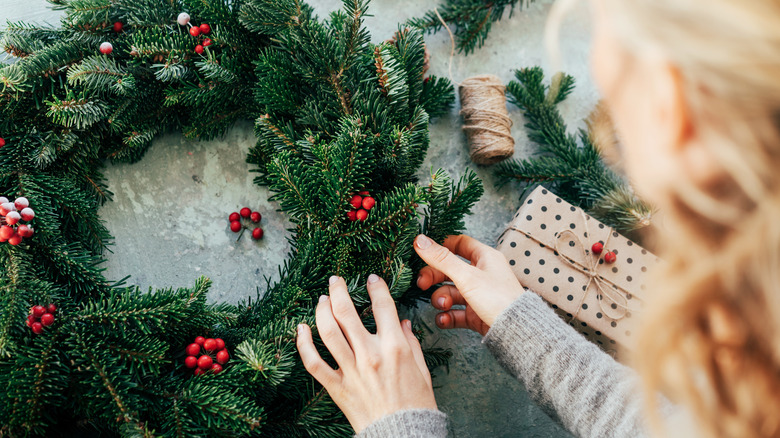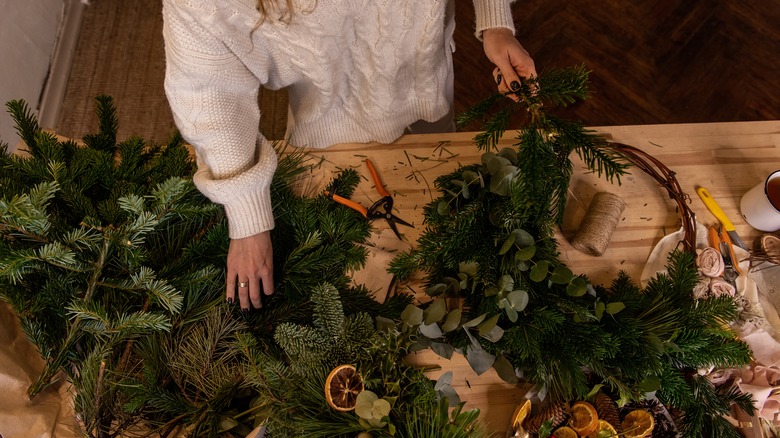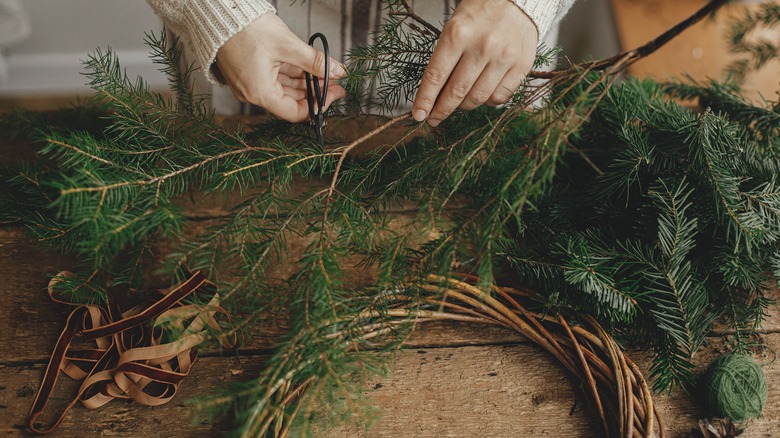How To Make An Inexpensive Holiday Wreath For Your Door With Natural Materials
Hanging a wreath on the door during the winter holidays is a popular tradition, and the variety of wreaths available for purchase, from mass-produced plastic to hand-crafted natural ones, is enormous. But did you know that making your own wreath can be easy and affordable? Using an inexpensive rattan or willow wreath frame — with cut evergreens and other foraged materials and maybe some wire or glue — you can easily and inexpensively craft a beautiful natural wreath for your door to welcome in the holiday season.
The most important part of making your wreath starts with a circular frame — allowing you to easily attach greenery to it. Inexpensive wreath frames made of natural materials such as dried grapevine, rattan, or willow are sold at craft stores. Joanns sells a willow wreath frame for $19, and Michaels has one made from wild grapevine for $6. These frames are sturdy, easy to use, and come in handy year after year.
Once you select your wreath frame, you need some greenery to attach to it. You can buy evergreen boughs and other natural materials at your local nursery, ask your local Christmas tree seller for any discarded branches, cut them from your own trees and shrubs (or a neighbor's who permits you), or perhaps go foraging by rural roadsides in your area. Some materials can be found on the ground, such as pinecones, twigs, or chestnuts.
Materials for making a natural wreath
Virtually any kind of evergreens may be used in your winter display. Some evergreens that look and smell great include blue spruce, juniper, hemlock, pine, false cedar (arborvitae), yew, and fir. These come in many shades of green and a variety of textures and shapes. They will look wonderful mixed and layered together. Holly and ivy tend to dry out too quickly for use in wreaths, but you can try adding some holly berries if you wish.
You can also use other natural materials to decorate your wreath, such as pine cones, chokecherry clusters, juniper berries, or dried flowers. Despite being commonly referred to as "pine cones," these cones are found on other conifers like spruce and fir trees and come in many shapes and sizes. Some branches will have tiny cones grown on them, while others have longer, larger cones. Choosing pine cones with a small stem on the end makes them a bit easier to attach to your wreath. You can also use twigs from various trees for color contrast, such as from red dogwood, to add some interest. Twigs and pine cones can be decorated before being added to your wreath, if desired, with some craft paint or glue and glitter. This adds a bit of sparkle or color to your wreath, but it does detract slightly from the natural look. Still, consider using white paint and glitter for the look of snow.
How to assemble a wreath using natural materials
Before assembling your wreath, wear gloves to protect your hands and use bypass pruners to cut branches. The willow, rattan, or grapevine wreath frames have plenty of openings to attach your branches and twigs. Gather together your materials so you can visualize your design. Place them alongside each other to see which combinations you like. Trim your evergreen branches and boughs to between 3 to 6 inches long, as these are a good size to place in the wreath frame openings. Generally, you want to trim the needles, foliage, and smaller twigs from the lower part of the branches so they will slide into the openings, but leaving a few needles may also help secure the branches in place. As you add greenery to the frame, you will see how the branches curve naturally, and this will guide you in where to place them. Keep adding greenery so it overlaps and covers all of the wreath frame.
To attach other materials to your wreath, such as pine cones or berry clusters, you can use florist wire, twine, wire twist ties, or a bit of craft glue. These helpers can help keep things sturdy and held together. But if you arrange your greenery in multiple thick layers, you can add the other materials by simply tucking them between the evergreen branches. To keep your Christmas greenery fresh, mist it with a plant sprayer every few days.


